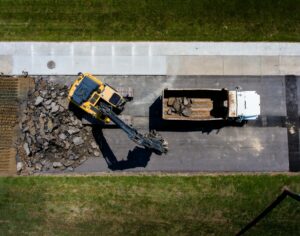Shaky foundations are no joke. The thought of literally having the ground fall out from underneath your home is enough to put off even the most interested buyer. Fortunately, underpinning is a commonly used method to fix up failing foundations. But what is underpinning? How does it work? Read on, and find out for yourself.
FAQs
What is underpinning?
Underpinning is the process of strengthening the foundations of a building to make it more secure. It is a significant structural engineering work that ensures a building won’t collapse under its own weight.
What does it mean if a house has been underpinned?
If a house has been underpinned, it means that the original foundations were no longer strong enough to secure the building. Either the original foundations were not laid correctly, or the ground has subsided since the building was completed.
Subsidence happens when the ground beneath a building sinks or shifts. This can be due to fluctuations in groundwater, earth tremors or regular soil instability caused by tree roots.
What is the process of underpinning?
The process of underpinning is essentially the digging out of the existing foundations and strengthening them. Qualified engineers will dig out a section at a time, and then use one of two main methods to secure the building’s weight with new ‘pins’ until they are satisfied that it is safely underpinned.

What are the two main types of underpinning?
The two main types of underpinning are mass concrete underpinning and mini-piled underpinning.
Mass concrete underpinning, or ‘traditional underpinning’ involves excavating a section of the foundations then backfilling it with concrete. This process is repeated until the reinforced foundations can safely bear the weight of the whole building.
Mini-piled underpinning requires more precise engineering and specialist equipment. Engineers either drive or drill steel piles below the existing foundations. This anchors the piles to subsoil up to 5 metres down. The process is more complex, but the equipment used is smaller, so it’s a viable technique for working in more confined spaces.
How long does it take to underpin a house?
It generally takes between 4-6 weeks to underpin a house. The amount of time taken will depend on the size of the house and the method of underpinning used. If there are any issues with the soil – such as unexpected subsidence or groundwater issues, then it will take longer.

Does underpinning last forever?
No structural engineering works last forever, including underpinning. It’s impossible to create everlasting foundations, as the soil can always potentially suffer from further subsidence. However, a successful underpinning of a house should last several lifetimes at least.
How much does it cost to underpin a house?
Underpinning a house can cost anywhere between £5000 and £35,000. The cost will mainly depend on the size of the house and the underpinning method used. Bigger houses cost more, and mini-piling costs more than mass concrete underpinning.

Is an underpinned house worth less?
Underpinning a house will very likely devalue it by demonstrating that it has an existing subsidence problem. There is no set amount of how much the property will fall in value. It will depend on the severity of the issue, and how well the underpinning was carried out.
However, underpinned houses can lose as much as 20-25% of their value.
Can you insure a house that has been underpinned?
It is possible to insure an underpinned house, but it will be more expensive to do so. There are specialist insurance providers with dedicated products for houses suffering from subsidence issues.
Can I get a mortgage on a house that has been underpinned?
It should be fine to secure a mortgage if the house you want to buy has been properly underpinned and subsequent surveys show that there are no further issues. Some lenders may be less willing to provide a loan for underpinned houses. However, it is a fairly common issue in many parts of the UK, so mortgage lenders know what to expect.
Are there alternatives to underpinning?
There are several alternatives to underpinning, but the main one is resin injection. Companies offering this solution will drill small holes in the ground at strategic points around your property. Then they will inject a specially formulated resin into those holes. The resin will follow the path of least resistance, flowing into underground cavities made by natural or manmade subsidence. It expands as it goes, filling in the holes and compacting the soil in the process.
Does resin injection work better than underpinning?
The resin injection method can be a cheaper, faster and more convenient alternative to underpinning. However, it may not be suitable, depending on the severity of your subsidence issue. This is why it’s essential to get expert advice, and possibly get two or three assessments from different companies, if you are able.
Hopefully, this FAQ has made you aware of the issue of subsidence and how underpinning affects property value. For more information on common structural issues and considerations for properties, check out some of our other guides below.
Read more
HomeViews provides verified resident reviews of the UK’s housing developments. We’re working with developers, landlords and the Government to recognise high performers and help to improve standards in the built environment.



















